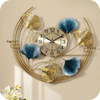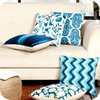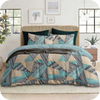

Decorative accents are the mysterious fixings that can transform a standard space into something remarkable. Whether you mean to make a comfortable niche, add a pop of variety, or basically cause your home to feel more customized, the right decorative accents can change your residing climate. From stylish wall art to unique planters, everything about it is causing your home to mirror your style and character. In this extreme aid, we'll investigate how to utilize decorative accents effectively and offer tips on coordinating them into different spaces.


Why Decorative Accents Matter
Decorative accents accomplish something other than occupying void spaces. They imbue warmth, inventiveness, and character into your home. The key is to adjust feel and usefulness. These components assist with tying a room together, create visual interest, and cause the space to feel lived-in and inviting. Decorative accents come in many structures: from cushions, throws, and rugs to artwork, mirrors, and vases. The beauty lies in how you combine them to create a cohesive look.


Types of Decorative Accents
Decorative accents come in a variety of shapes and sizes. Here’s a breakdown of the most popular types that you can use to enhance different areas of your home:
1. Wall Art and Mirrors
Wall art and mirrors are fundamental pieces for adding character and profundity to any room. Whether it's a striking painting, outlined photos, or a huge assertion mirror, these accents can, in a split second, raise a room's style. Mirrors not only mirror light and cause a space to feel bigger, but in addition, they act as a useful stylistic layout. Wall art, then again, can convey feeling, add tone, and set the vibe of a room.
2. Throw Pillows and Cushions
Throw pillows are among the simplest and most reasonable ways of refreshing the vibe of a room. Accessible in different sizes, shapes, and textures, they can be blended and matched to make layers of surface and variety. Whether on a couch, seat, or bed, cushions give both solace and style, making them ideal for lounges and rooms.
3. Rugs and Carpets
A wonderful rug can moor a room, particularly in bigger spaces with hardwood or tile floors. Rugs give warmth and surface while supplementing the variety plan of your room. Look over various examples, from intense mathematical plans to complex florals, to make a feeling of concordance and difference.
4. Vases and Planters
Vases and planters are flexible accents that can work in any room. Loaded up with new blossoms, vegetation, or even enhancing branches, they carry life to your space. Select present-day glass vases or ceramic planters to match the style of your stylistic layout, and remember to think about the actual plants, as they add a natural touch.
5. Lighting Fixtures
Lighting is a frequently disregarded part of home style, yet the right installations can have a colossal effect. Proclamation lightings, like ceiling fixtures, pendant lights, or floor lights, can be both useful and decorative accents. Lighting accents assist with setting the general vibe and feature other decorative accents.
6. Decorative Bowls and Trays
Bowls, trays, and bushels are practical as well as decorative. They can hold anything from natural products to keys and little knickknacks while adding surface and interest to a footstool or ledge. Choose smooth metallic completions or finished artistic plans relying upon your inside style.


How to Integrate Decorative Accents Into Your Home
Once you’ve chosen the decorative accents that speak to you, it’s time to integrate them into your home. Here are some tips on how to do so effectively:
1. Consider the Room's Functionality
Prior to adding decorative accents, contemplate the room's essential capability. A parlor might profit from toss pads, workmanship pieces, and rugs, while a lounge area can profit from tablecloths, rich containers, and sleek lighting. A room could require quieting, delicate accents like cushions, comfortable tosses, and craftsmanship to make a tranquil air.
2. Balance Color and Texture
Decorative accents permit you to play with variety and surface, yet balance is vital. Try not to overburden the space with an excessive number of strong shades or conflicting examples. All things considered, hold back nothing and fluctuating surfaces. For instance, match a delicate wool rug with smooth cowhide cushions or consolidate a metallic vase with a cotton toss cover.
3. Mix and Match Styles
Don't hesitate for even a moment to blend styles. Match present-day pieces with rare things, or join moderate accents with additional fancy ones. This combination adds profundity and interest to your stylistic layout, giving your home a layered, organized feel.
4. Play with Proportions
Utilize various sizes of accents to make a reasonable synthesis. For example, match a huge, striking piece of wall art with more modest, more sensitive accents like candles or outlined photographs. Essentially, balance an enormous vase with a more modest plant on a similar table or rack.
5. Don’t Overcrowd
While it's enticing to occupy each space with decorative accents, in some cases toning it down would be best. Stuffing a room with an excessive number of extras can cause it to feel jumbled and disrupted. Center around key pieces that improve the general energy of the room without overpowering the space.


The Benefits of Using Decorative Accents
Decorative accents not only enhance your home’s aesthetic but also offer several other benefits:
- Increased Comfort: Accents like cushions, rugs, and tosses make a comfortable air that makes your home really welcoming.
- Personal Expression: They permit you to exhibit your own style, whether it's through variety, surface, or subject.
- Improved Functionality: Certain decorative accents, similar to plates, bowls, and planters, fill functional needs while looking smart.
- Visual Interest: Decorative accents separate repetitiveness and change up your rooms.
- Affordable Makeover: Little changes, for example, adding a couple of key accents, can totally change a space without the requirement for costly redesigns.



Conclusion
Decorative accents are a brilliant method for mixing character into your home without undertaking a full-scale overhaul. Whether you're integrating workmanship, materials, or plants, these accents upgrade the look and feel of your space while additionally mirroring your remarkable style. With the right mix of decorative accents, your home can turn into a more lively, agreeable, and practical space that really feels like your own. Remember to try different things with various styles, surfaces, and arrangements to accomplish the ideal equilibrium between feel and capability!
By decisively utilizing decorative accents, you can raise your home's stylistic theme and make a space that feels welcoming, snappy, and individual.
1. What are decorative accents, and why are they important?
Decorative accents are items like rugs, vases, mirrors, and cushions that enhance the look of your home. They add personality, warmth, and visual interest to any space.
2. How do I choose the right decorative accents for my home?
Consider your room’s style, color scheme, and functionality. Balance textures, colors, and proportions to create a cohesive and inviting space.
3. Can decorative accents make small spaces look bigger?
Yes, items like mirrors can reflect light and create an illusion of more space, while carefully placed accents can enhance a room’s openness.
4. What are the best decorative accents for a cozy living room?
Throw pillows, rugs, soft lighting, and vases with fresh flowers or greenery are perfect for creating a warm, inviting living room.
5. How often should I update my decorative accents?
There’s no set rule! Refresh accents seasonally or whenever you want to change the vibe of your space without a complete overhaul.















